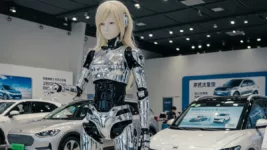The relentless march of technology continues to infiltrate every aspect of our lives, and even the traditionally human-centric world of car sales is not immune. Chinese automaker Chery has reportedly begun experimenting with using humanoid robots as sales representatives in their car showrooms, a move that is as intriguing as it is potentially… unsettling. While the initial draw of a talking, gesturing automaton might be undeniable, the long-term efficacy of these metallic marketers remains a significant question mark, particularly when the specter of the “uncanny valley” looms large.
The Initial Allure: Robot Curiosity
Let’s face it, a humanoid robot standing next to a gleaming new SUV is going to turn heads. The novelty factor alone is a powerful magnet, pulling potential buyers into Chery dealerships out of sheer curiosity. People will want to see these mechanical marvels in action, to witness their interactions firsthand and assess their capabilities. In a crowded marketplace, this initial buzz and foot traffic could provide Chery with a temporary advantage, a talking point (literally) that sets them apart from the competition. It’s the automotive equivalent of a circus coming to town – you just must see the robotic ringmaster.
Navigating the Uncanny Valley: A Cold Shoulder from Chrome?
However, the initial fascination might quickly give way to a creeping sense of unease, particularly if these robots fall on the wrong side of the “uncanny valley” (Understanding the Uncanny Valley). This psychological phenomenon, first proposed by roboticist Masahiro Mori, describes the dip in human affinity for robots as they become increasingly human-like in appearance and motion, yet still retain subtle imperfections that trigger feelings of revulsion or discomfort. Think of a slightly too-realistic animated character – it’s not human, and that “not quite” is deeply unsettling.
In a sales situation, where trust and rapport are crucial, a robot stuck in the uncanny valley could be a significant liability. Instead of building enthusiasm for a new car, a stilted gesture, an unnatural gaze or a voice that’s just a hair off could create a barrier between the potential buyer and the brand. Customers might find the interaction awkward, insincere or even a little creepy, hardly the emotions you want associated with a major purchase like a vehicle.
Eastern Negotiation Expertise: Fueling Better Sales AI?
Interestingly, Eastern cultures, including China, often place a significant emphasis on the art of negotiation, with nuanced strategies and deep-rooted cultural understanding. This expertise, honed over centuries, could potentially provide a rich dataset for training sophisticated sales AIs. If Chery and other Eastern automakers can effectively codify these intricate negotiation tactics into their robotic sales reps, they might develop AI with a distinct advantage in guiding customers through the sales process and closing deals. This advanced negotiation AI, built upon a foundation of cultural understanding, could hold significant international interest for companies looking to enhance their own sales automaton.
Premature Automation, Foundational Gains
While the current iteration of robotic car sales reps might be more of a spectacle than a sales powerhouse, this foray into automation is a crucial step in building a foundation for future, more performant offerings. The data gathered from these early deployments – how customers interact with the robots, what questions they ask, where the robots succeed and fail – will be invaluable in refining the AI and the robotic hardware. Think of it as a very public and slightly awkward beta test.
Robots in the East: A Broader Automation Landscape
China (Robotics in China), and other Eastern nations like Japan (Humanoid Robots in Japan), are already embracing robotics in various sectors. From automated factories churning out electronics at lightning speed to robots assisting in healthcare and hospitality, the integration of machines into daily life is accelerating. Japan, in particular, has a long history of humanoid robot development (Honda Asimo Robot History). Chery’s robotic sales force is simply another manifestation of this broader trend, a tentative step into a future where human-robot interaction becomes increasingly commonplace in commercial settings.
The Robotic Revolution: Peering into What Comes Next
Chery’s experiment, while a bit clunky in its initial stages, offers a tantalizing glimpse into the near future of robotics in commerce and beyond. What’s likely to follow this initial foray?
Advancements in AI and Humanoid Design: We can anticipate rapid advancements in AI (AI Development Trends) leading to robotic sales reps with far more natural language processing capabilities that are able to understand and respond to complex queries with genuine nuance. The uncanny valley will likely be traversed as robotic design (Advancements in Robotics Design) and motor control become more sophisticated, creating androids that are virtually indistinguishable from humans in appearance and movement.
Proliferation of Specialized Robots: Beyond sales, expect to see a proliferation of specialized robots in various customer-facing roles. Think of robotic concierges in hotels with encyclopedic knowledge and flawless multilingual skills, or robotic baristas crafting your latte with artistic precision. In elder care (Robots in Elder Care), robots will provide companionship and assistance with daily tasks, freeing up human caregivers for more complex emotional support. Logistics will be revolutionized by autonomous delivery robots (Autonomous Delivery Robots) navigating our streets and even our homes.
Integration with Augmented Reality: Furthermore, the integration of robots with augmented reality (AR) (Robotics and Augmented Reality) could create entirely new interactive experiences. Imagine an AR overlay allowing a robotic sales rep to project detailed product information directly into your field of vision, or a robotic tour guide in a museum augmenting your experience with historical reenactments.
Democratization of Robotics: The development of more affordable and adaptable robotic platforms (Affordable Robotics Platforms) will also democratize access to this technology, allowing smaller businesses to leverage automation in innovative ways. Open-source robotics platforms, similar to what we see in AI today, could further accelerate this trend (Open Source Robotics Foundation).
Ethical and Societal Considerations: However, this robotic revolution won’t be without its challenges. Ethical considerations surrounding job displacement (Ethical Implications of Robotics), data privacy and the potential for over-reliance on automation will need careful consideration and robust regulatory frameworks. The human element, while potentially augmented, should not be entirely replaced in roles requiring empathy and complex emotional intelligence.
The Inevitable Evolution: Ultimately, Chery’s robotic sales force, while perhaps a bit clunky in its initial stages, is a signpost pointing towards a future where robots are not just confined to factory floors but are increasingly integrated into our daily interactions, blurring the lines between the physical and the digital in ways we are only beginning to imagine here in Bend, Oregon, and across the globe. The revolution has started, and the next iterations promise to be far more performant, seamless and a little less uncanny.








